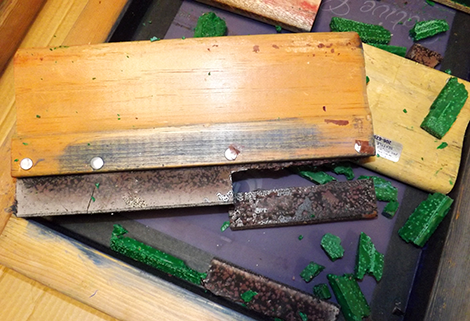The Right Tools For The Job - Part 2
November 11, 2015

In Part 1 of this article, Kieth Stevens discussed the importance of using the right tool for the job, specifically some attributes about squeegees, such as durometer/hardness. If you missed the post, you can read it here.
To see the entire article as published in Specialist Printing Worldwide, Issue One 2015, you can read the PDF here.
Part 2:
SQUEEGEES - Continued
Composite Blades
As I mentioned in Part 1, some squeegees are composed of a “sandwich” of different durometer blades. This type of squeegee blade consists of dual or triple blades of varying durometers sandwiched together, such as a 60/90 or a 70/90/70. The benefit to using this type is that the harder durometer gives the squeegee great support, yet has the softer edge for printing.
The disadvantage of the multi durometer i.e. 60/90 is that since only the side with the soft edge is used for printing, over time, the squeegee will curl to one direction. Hence the invention of the triple blade, where both sides of the blade can be used for printing and can therefore be balanced and kept straight.
Due to harsh cleaning chemicals and age, squeegees over time will become harder in durometer or even become brittle. So keep that in mind and when you think it’s time, go ahead and get a new blade. You may be surprised at the difference a new blade can make.
Squeegee Profile
For textile screen printing, there are generally three different types of blade profiles: Square, round and V-shaped.
- Square (straight edge) blades are most often used by screen printers. They work well for standard or regular ink applications.
- Round (bull nose) squeegee blades deposit more ink. Use this type for special effects inks such as gel or puff.
- V-shaped (single- or double-bevel) blades are typically used for printing on irregular or cylindrical-shaped substrates
Handles
A squeegee consists of two parts: a blade and the holder for the blade. It’s seems like a simple design; however, the holder comes in various shapes and materials, and is designed for different functions.
- For manual screen printing, for example, the holder essentially becomes the handle of the squeegee. Of importance to the printer is how the handle feels when holding the squeegee, especially after several hours of printing.
- Wood, aluminum or plastic are the most popular materials used for handles, and each has its following. Fans of the wooden handles like the organic feel and warmth of wood, whereas fans of the newer plastic or aluminum handles prefer them for their easy-to-clean properties. (Just a heads up: Since wood is absorbent it soaks in much of the cleaning chemicals).
Colors
Squeegee manufacturers also color their blades, but don’t be deceived: The same red blade from one manufacturer does not necessarily sport the same features as the red blade from another maker. I’ve often heard screen printers order “a red squeegee blade” or “a yellow squeegee, please” expecting the blade to be of the same durometer across different brands. In reality, brand “A” might use red to mark their 60 durometer blade whereas brand “B” uses red for their 90 durometer blade. So ask for squeegees by durometer value rather than color.
Next week we'll post Part 3, where Kieth will discuss the importance of using the right mesh, such as thread count and thread diameter. Stay tuned...


